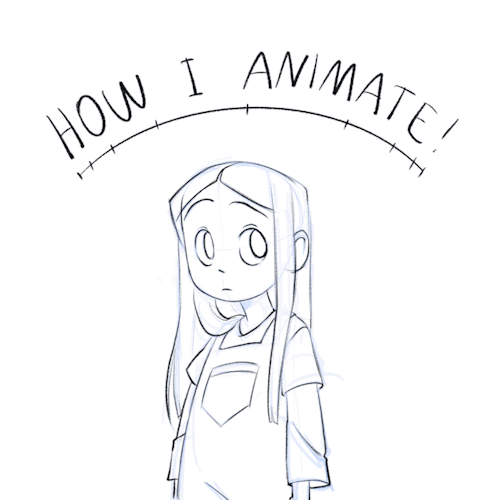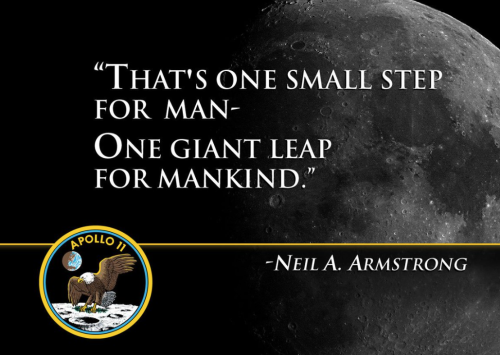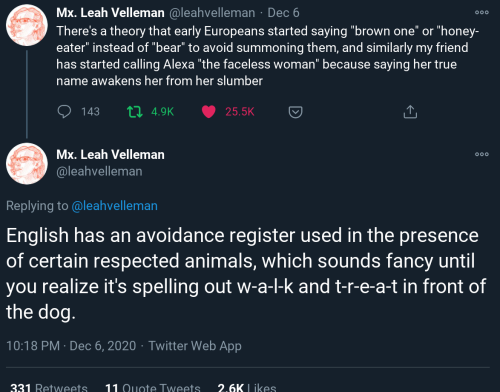HOW I ANIMATE 🤌

HOW I ANIMATE 🤌
I couldn’t make individual gifs of this whole this so MADE A VIDJEW FOR YEW GOIS ! I didn’t know what else to make of my animation, so I decided to make it into a little quick tutorial. Hope it helps!
More Posts from Lilhaileyfoofoo and Others
How the media depicts the Apollo 11 mission:

Actual quotes from the Apollo 11 mission:







There’s a theory that early Europeans started saying “brown one” or “honey-eater” instead of “bear” to avoid summoning them, and similarly my friend has started calling Alexa “the faceless woman” because saying her true name awakens her from her slumber
English has an avoidance register used in the presence of certain respected animals, which sounds fancy until you realize it’s spelling out w-a-l-k and t-r-e-a-t in front of the dog.
Mx. Leah Velleman on twitter
this shit’s like straight out of a parks and rec episode

More often than not I’ll crack into a sprawling fantasy series and, while I appreciate the luscious descriptions of furniture, landscapes, and clothing, all I’m focused on is that I don’t actually know how this world works. I only know what it looks like.
Including some functionality to your universe can add to immersion and give your reader a strong foundation on which to build their mental model of your universe.
You certainly don’t need to use all of these questions! In fact, I recommend against that, as all of these certainly won’t make it into your final draft. I personally find that starting my worldbuilding off with 5 to 10 functional questions helps pave the way for glittery and elaborate aesthetic development later on.

How is the healthcare funded in your world?
How does healthcare functionally differ between the wealthy and the poor? (i.e. can only the wealthy go to hospitals? do poor families often have to rely on back-alley procedures?)
Where are health centers (i.e. hospitals, small clinics, etc.) organized in your cities?
Does it differ in smaller towns?
How does this affect people’s ability to get healthcare?
Is healthcare magical, and if it is, how does that affect the healthcare system?
If healing is instantaneous, how does that affect people’s views on injury, illness, and chronic ailments?
If you have both magical and physical healthcare, which one is deemed superior and how does that affect society?
What illnesses are common in your world?
How does this affect daily life?
What do the people in your world think illnesses are?
Is it a miasma theory?
Humor theory?
Demons?
Do they know about biological viruses and bacteria?
How does this affect healthcare?

How do people get water?
Is the water sanitary and if not, how do they sanitize it?
How does agriculture work?
Is it large corporations or individual farms?
What sort of agricultural technology exists in your world and how does it affect food production?
Are farmers wealthy or poor?
What sort of natural resources does your world/country(ies) have and how are they obtained?
How does this affect the average wealth of the country?
How does this wealth affect the culture?
What livestock or beasts of burden are most valued? Least valued? Why?
What is considered a luxury good vs. a regular good?

What forms of transportation does your world have?
What classes use what forms of transportation?
How far has the average citizen traveled, given your transportation limitations?
Which cities are the most accessible and which are the least? Why?
How do popular transportation methods change how cities/towns are laid out?
Does your world have public transportation? What is it?
Is there a coming-of-age aspect to travel?
Describe your world’s postal system or whatever equivalent there is.
Who pays for it?
How reliable is it?
Are there emergency methods for transporting information?

How does your world keep time (i.e. watches, sundials, water clock, etc.)?
Does your world have a currency system, barter system, or something else?
If you have multiple countries, do different currencies have different values across said countries?
How does this affect travel?
Do you have banks in your world and if so, how are they run?
Who owns the banks? Government? Wealthy? How does this affect the economy and/or class system?
How does credit operate in your universe?
Does your world operate more on big corporations or small business? Something in between?
How are workers/labourers treated in your world?
Are there workers unions and if so, what are common views on unions?
Describe your tax system. If you don’t have a tax system, explain why and how your world is affected by that.
Can certain social classes not own property, certain livestock, certain businesses, etc.? Why?
How are business records kept? Are business records kept?
If your world has technology, does your world prioritize developing entertainment tech, communications tech, transportation tech or something else entirely?
What does this say about your world?
How does this affect your economy?

To the closest approximation, what type of government does your world have?
How are rulers/presidents/nobles put in place?
How much power does an individual ruler have?
Is there a veto process?
If you have multiple countries, do they have different types of rulers?
Describe any large-scale alliances (i.e. countries, factions, etc.) that are present in your world.
How did they come about and how are they maintained?
Are they strained or peaceful?
How does it affect the greater politics of your world?
Describe how wars are fought both internationally and nationally.
Do methods of war differ between countries/races?
What about philosophies about war?
If there is a military, what is its hierarchy structure?
How does the military recruit?
Is the military looked upon favourably in your society?
What weapons are used by each country/type of people during warfare, and how does that affect war strategies?
Describe the sentencing system of your world.
Is your accused innocent until proven guilty, or guilty until proven innocent?
How are lawbreakers punished?
If you have prisons, describe how they are organized and run, and who owns them.
Does differing ownership change how the prisons operate?
What are the major ways in which laws between countries vary?
Do laws between cities vary? If so, how and why?
How does citizenship work in your world? What rights and privileges do citizens have that others do not?
Can certain classes or races not become citizens?
Are there certain taboo subjects or opinions that artist/authors/musicians are not allowed to depict (i.e. portraying the official religion in a negative light, explicit sexual material, etc.)? What does this say about your society?
How do people get around these censorship laws?
What is the official hierarchy of duty in your world? (i.e. is family the most important, or patriotism? What about clan?)
How many languages are there in your world, and how many languages share a common origin?
How many people are multilingual?
Which language is the most common?
How is multilingualism viewed?
How are different languages viewed? (i.e. is one language ugly/barbaric while another is romantic and sensual?)
Feel free to add your own questions in reblogs or in comments!
i'm so tired of the online art influencer mentality that in a sketchbook everything in it has to look amazing and polished and flawless it's so performative!!!! sketchbooks should be for drawing stupid shit
Music of the Mojave Wasteland (x)
when u have so many things u want to draw that it becomes overwhelming so u just do nothing

Writing Traumatic Injuries References
So, pretty frequently writers screw up when they write about injuries. People are clonked over the head, pass out for hours, and wake up with just a headache… Eragon breaks his wrist and it’s just fine within days… Wounds heal with nary a scar, ever…
I’m aiming to fix that.
Here are over 100 links covering just about every facet of traumatic injuries (physical, psychological, long-term), focusing mainly on burns, concussions, fractures, and lacerations. Now you can beat up your characters properly!
General resources
WebMD
Mayo Clinic first aid
Mayo Clinic diseases
First Aid
PubMed: The source for biomedical literature
Diagrams: Veins (towards heart), arteries (away from heart) bones, nervous system, brain
Burns
General overview: Includes degrees
Burn severity: Including how to estimate body area affected
Burn treatment: 1st, 2nd, and 3rd degrees
Smoke inhalation
Smoke inhalation treatment
Chemical burns
Hot tar burns
Sunburns
Incisions and Lacerations
Essentials of skin laceration repair (including stitching techniques)
When to stitch (Journal article–Doctors apparently usually go by experience on this)
More about when to stitch (Simple guide for moms)
Basic wound treatment
Incision vs. laceration: Most of the time (including in medical literature) they’re used synonymously, but eh.
Types of lacerations: Page has links to some particularly graphic images–beware!
How to stop bleeding: 1, 2, 3
Puncture wounds: Including a bit about what sort of wounds are most likely to become infected
More about puncture wounds
Wound assessment: A huge amount of information, including what the color of the flesh indicates, different kinds of things that ooze from a wound, and so much more.
Home treatment of gunshot wound, also basics More about gunshot wounds, including medical procedures
Tourniquet use: Controversy around it, latest research
Location pain chart: Originally intended for tattoo pain, but pretty accurate for cuts
General note: Deeper=more serious. Elevate wounded limb so that gravity draws blood towards heart. Scalp wounds also bleed a lot but tend to be superficial. If it’s dirty, risk infection. If it hits the digestive system and you don’t die immediately, infection’ll probably kill you. Don’t forget the possibility of tetanus! If a wound is positioned such that movement would cause the wound to gape open (i.e. horizontally across the knee) it’s harder to keep it closed and may take longer for it to heal.
Broken bones
Types of fractures
Setting a broken bone when no doctor is available
Healing time of common fractures
Broken wrists
Broken ankles/feet
Fractured vertebrae: Neck (1, 2), back
Types of casts
Splints
Fracture complications
Broken noses
Broken digits: Fingers and toes
General notes: If it’s a compound fracture (bone poking through) good luck fixing it on your own. If the bone is in multiple pieces, surgery is necessary to fix it–probably can’t reduce (“set”) it from the outside. Older people heal more slowly. It’s possible for bones to “heal” crooked and cause long-term problems and joint pain. Consider damage to nearby nerves, muscle, and blood vessels.
Concussions
General overview
Types of concussions 1, 2
Concussion complications
Mild Brain Injuries: The next step up from most severe type of concussion, Grade 3
Post-concussion syndrome
Second impact syndrome: When a second blow delivered before recovering from the initial concussion has catastrophic effects. Apparently rare.
Recovering from a concussion
Symptoms: Scroll about halfway down the page for the most severe symptoms
Whiplash
General notes: If you pass out, even for a few seconds, it’s serious. If you have multiple concussions over a lifetime, they will be progressively more serious. Symptoms can linger for a long time.
Character reaction:
Shock (general)
Physical shock: 1, 2
Fight-or-flight response: 1, 2
Long-term emotional trauma: 1 (Includes symptoms), 2
First aid for emotional trauma
Treatment (drugs)
WebMD painkiller guide
Treatment (herbs)
1, 2, 3, 4
Miscellany
Snake bites: No, you don’t suck the venom out or apply tourniquettes
Frostbite
Frostbite treatment
Severe frostbite treatment
When frostbite sets in: A handy chart for how long your characters have outside at various temperatures and wind speeds before they get frostbitten
First aid myths: 1, 2, 3, 4, 5 Includes the ones about buttering burns and putting snow on frostbite.
Poisons: Why inducing vomiting is a bad idea
Poisonous plants
Dislocations: Symptoms 1, 2; treatment. General notes: Repeated dislocations of same joint may lead to permanent tissue damage and may cause or be symptomatic of weakened ligaments. Docs recommend against trying to reduce (put back) dislocated joint on your own, though information about how to do it is easily found online.
Muscular strains
Joint sprain
Resuscitation after near-drowning: 1, 2
Current CPR practices: We don’t do mouth-to-mouth anymore.
The DSM IV, for all your mental illness needs.
Electrical shock
Human response to electrical shock: Includes handy-dandy voltage chart
Length of contact needed at different voltages to cause injury
Evaluation protocol for electric shock injury
Neurological complications
Electrical and lightning injury
Cardiac complications
Delayed effects and a good general summary
Acquired savant syndrome: Brain injuries (including a lightning strike) triggering development of amazing artistic and other abilities
Please don’t repost! You can find the original document (also created by me) here.








some puppies studies ( ͡° ͜ʖ ͡°) 🐶 | Instagram
(Edited) + more studies lkdafña
-
 firewarriorjedi liked this · 2 weeks ago
firewarriorjedi liked this · 2 weeks ago -
 anxioustrashpanda liked this · 2 weeks ago
anxioustrashpanda liked this · 2 weeks ago -
 pepeonette reblogged this · 2 weeks ago
pepeonette reblogged this · 2 weeks ago -
 rapidkirby3000 liked this · 2 weeks ago
rapidkirby3000 liked this · 2 weeks ago -
 grandpeace-witch reblogged this · 2 weeks ago
grandpeace-witch reblogged this · 2 weeks ago -
 grandpeace-witch liked this · 2 weeks ago
grandpeace-witch liked this · 2 weeks ago -
 artostratusphere reblogged this · 2 weeks ago
artostratusphere reblogged this · 2 weeks ago -
 pepeonette liked this · 2 weeks ago
pepeonette liked this · 2 weeks ago -
 nenenianenhs liked this · 3 weeks ago
nenenianenhs liked this · 3 weeks ago -
 75210 liked this · 3 weeks ago
75210 liked this · 3 weeks ago -
 illmeetyouforcoffee liked this · 3 weeks ago
illmeetyouforcoffee liked this · 3 weeks ago -
 ghostlylexie reblogged this · 3 weeks ago
ghostlylexie reblogged this · 3 weeks ago -
 ghostlylexie liked this · 3 weeks ago
ghostlylexie liked this · 3 weeks ago -
 bloodmoonbloodstarlife liked this · 4 weeks ago
bloodmoonbloodstarlife liked this · 4 weeks ago -
 krislgfox liked this · 1 month ago
krislgfox liked this · 1 month ago -
 tintasdeluna reblogged this · 1 month ago
tintasdeluna reblogged this · 1 month ago -
 gayghost69 liked this · 1 month ago
gayghost69 liked this · 1 month ago -
 themidoripanda reblogged this · 1 month ago
themidoripanda reblogged this · 1 month ago -
 themidoripanda liked this · 1 month ago
themidoripanda liked this · 1 month ago -
 keeperesque liked this · 1 month ago
keeperesque liked this · 1 month ago -
 tobiltop reblogged this · 1 month ago
tobiltop reblogged this · 1 month ago -
 tobiltop liked this · 1 month ago
tobiltop liked this · 1 month ago -
 page-vacat liked this · 1 month ago
page-vacat liked this · 1 month ago -
 snailpurr reblogged this · 1 month ago
snailpurr reblogged this · 1 month ago -
 snailpurr liked this · 1 month ago
snailpurr liked this · 1 month ago -
 lundeo-art-collection reblogged this · 1 month ago
lundeo-art-collection reblogged this · 1 month ago -
 grapplemace liked this · 1 month ago
grapplemace liked this · 1 month ago -
 gh0stedvhampir reblogged this · 1 month ago
gh0stedvhampir reblogged this · 1 month ago -
 gh0stedvhampir liked this · 1 month ago
gh0stedvhampir liked this · 1 month ago -
 moechainsmoker liked this · 1 month ago
moechainsmoker liked this · 1 month ago -
 himbopunk reblogged this · 1 month ago
himbopunk reblogged this · 1 month ago -
 himbopunk liked this · 1 month ago
himbopunk liked this · 1 month ago -
 moemothra reblogged this · 1 month ago
moemothra reblogged this · 1 month ago -
 lostinthesouce reblogged this · 1 month ago
lostinthesouce reblogged this · 1 month ago -
 aliskpraline liked this · 1 month ago
aliskpraline liked this · 1 month ago -
 zelyonn reblogged this · 1 month ago
zelyonn reblogged this · 1 month ago -
 zelyonn liked this · 1 month ago
zelyonn liked this · 1 month ago -
 jhunhuujj liked this · 1 month ago
jhunhuujj liked this · 1 month ago -
 art-tutorials-and-refs reblogged this · 1 month ago
art-tutorials-and-refs reblogged this · 1 month ago -
 mrsketchy liked this · 1 month ago
mrsketchy liked this · 1 month ago -
 qu5ar liked this · 2 months ago
qu5ar liked this · 2 months ago -
 melangeknottings liked this · 2 months ago
melangeknottings liked this · 2 months ago -
 imj03l liked this · 2 months ago
imj03l liked this · 2 months ago -
 stitched-rabbit00 reblogged this · 2 months ago
stitched-rabbit00 reblogged this · 2 months ago -
 stitched-rabbit00 liked this · 2 months ago
stitched-rabbit00 liked this · 2 months ago -
 absolutely-n-o-t-h-i-n-g reblogged this · 2 months ago
absolutely-n-o-t-h-i-n-g reblogged this · 2 months ago

I mostly reblog writing and art related resources here. BLMMy main account is FoofsterRoonie. My art blog is FoofsterArtAnd my writing blog is Foofsterwriting:)
197 posts